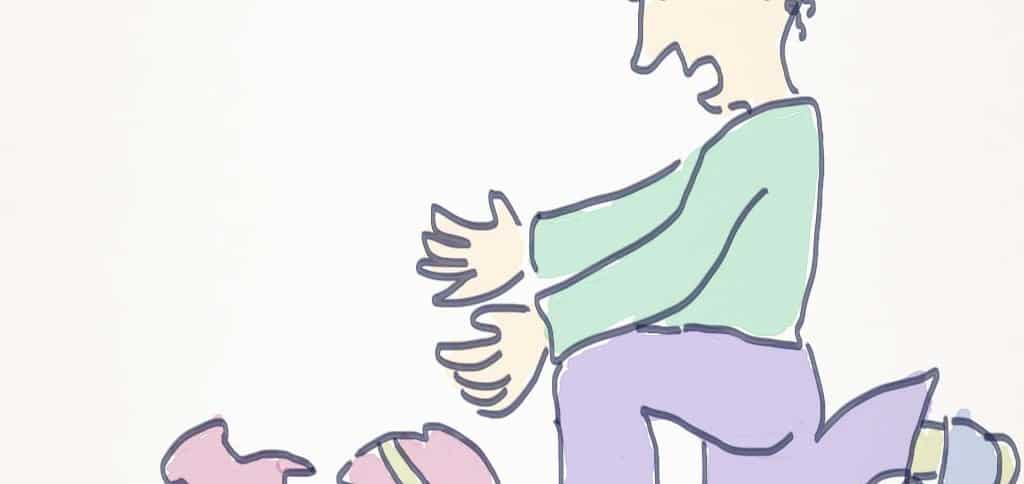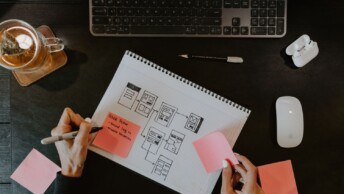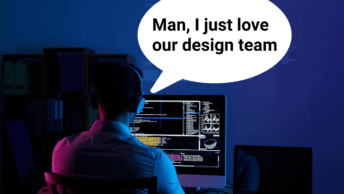Like most UX designers, I made plenty of mistakes when I first started designing websites and apps.
However, the single biggest mistake I made when I first started out as a designer, by far, was probably not what you think.
It wasn’t that I chose the wrong typeface, or deleted a client’s customer database, although that was pretty bad (we managed to restore it). Agreeing to answer questions about the client’s printer setup wasn’t it either, although in hindsight that was a pretty big one…
The biggest mistake I made was to be arrogant in my design decisions.
What do I mean by “arrogant”?
Let me explain. Here’s how I approached one of my first web design projects, years ago. The task was to redesign the home page of a website. Here’s how we went about it.
- Mock up a few different designs in Photoshop.
- Run my best three ideas past the client.
- Make a few changes based on their feedback, and show the selected design to the client.
- Discuss the design. Make a few more changes. Defend some of my decisions, whilst barely managing to avoid a full-on heated argument, and find a way to reach a compromise in the design.
- Launch the redesign.
- Scratch our heads and wonder why traffic hasn’t increased and conversions have dropped.
Can you spot the arrogance in this process?
It’s this: there is no input from actual users. Ever. Everyone involved in the process assumes that they know best. As a mid-level designer, I assumed that a couple of years of working on personal websites would mean that I was well placed to pre-empt what this website’s users would want. I was wrong.
Now, to be fair to myself, I didn’t have the final say in this process. Other than being ignorant of what we might have done better, it was dictated to me that this was how things would be done. Of course, knowing what I know now, there’s no way I would have agreed to this process—it’s a recipe for failure. But at the time I didn’t know any better, so I didn’t offer an alternative approach.
So what could we have done to ensure a better outcome? Here are four to begin with:
- We didn’t interview any users during the design process. We thought we’d done enough by reading through the responses from a survey we’d conducted a couple of years prior; unfortunately all that really told us was the type of content and features people wanted, so we abandoned the usefulness of these results as being too diverse to fold into anything useful. Instead, we should have interviewed some readers who lived in the area.
- We didn’t solicit remote feedback, either. We had a customer list that we could have reached out to; we also could have used JavaScript to display a popup message to readers based in Melbourne, inviting them to participate in a feedback session. 9 or 10 interviews with visitors to the site would likely have yielded enough useful information to identify some patterns.
- We should have established a baseline by doing some user testing on the old site. The client had a vision for what the business goals for the site were, but nobody asked the users what their goals were, nor did we watch anyone use the site to see what issues they had with it. Running a couple of user tests of the existing site would have taken half a day, would have helped us identify the main usability issues, and helped us prioritise the new design..
- We didn’t do any user testing on the new design while it was in development, either. Not really. I’d posted mockups on the wall in order to get feedback from my colleagues and passers by, but those people were not the target audience, so their opinions, while interesting, didn’t actually matter.
- Finally, we could have launched the site to a select group of beta testers, to gauge their feedback, before making it live to the public. Having a conversation with this group of willing early adopters would have given us some insights into the why people liked or did not like a certain feature. Instead all we had were stats from our web analytics tool, which painted a bleak picture but didn’t reveal why the new design was failing to please the site’s visitors. We were impatient to get it done, but the very audience we were designing for had no input in the process, so it’s no wonder they were critical of it once it went live.
The toolkit of techniques available to UX designers is broad and varied. I’ve touched on five in this post, but there are a ton of other approaches that might have also been useful (check out Luke’s recent post on small-budget, time-poor approach to UX design for more). Knowing which technique to use in which circumstance is a skill that comes with experience, and something I hope to cover more on this blog in the future.
I probably still make mistakes when designing, but I’ve certainly learned a lot about what works and what doesn’t from the mistakes of my past. For now, I’d love to hear from you. What is one of the biggest mistakes you’ve made when designing a website or application?
Share your story with us (use a pseudonym if you’d rather not mention specific client details!)






Great article, Matt. The other advantage of starting with the end (user) in mind is that it makes developing the content – text, images, links, etc. – more focused and straightforward to compile.
For example, in my current site redesign project I analysed a range of sources (client strategies, existing website, industry keywords, etc.) and sent a quick survey, helping me understand potential visitor interests. I created three broad audience personas and analysed the data through these perspectives. I then interviewed persona “representatives” for anecdotal information; understanding what sort of language to use and to give the visual designer a really useful brief. With this cheap, quick approach I was then able to outline and partially write 20 pages in one day!
With cost savings and improved customer experience as rewards, it should be easy to get across the power of this business intelligence – not just for the system being redesigned or improved but for the business/organisation in general.
Keep up the interesting articles.
Thanks Malcolm! You’re spot on—content is not only easier to create/compile after you’ve done some user research, but will end up being more relevant and relatable. Surveys and interviews are a great place to start (and cheap to do) and can provide great insights.
Wonderful article, just brings back old memories when I read this. The biggest mistake that I made in my first project was ignoring (taking them very lightly) the users. Fortunately, that project was part of my thesis at Stanford so did not cost me in terms of $$$. When I was supposed to observe and do my user research, I sent out surveys and questionnaires and avoided going out in field and interviewing them. I totally ignored the famous saying in UX that users say something and do something altogether different. I still come across so many people who take user research for granted and my only advice to them is spend as much time possible in interacting and observing users, development does not take much time. Starting on wrong foot is going to delay the project as it is and cost you $$$$.
Too true Shital—I also was guilty back in the day of assuming that a survey on its own would suffice. This David Attenborough quote comes to mind, as it could be used to describe developers and users.
“I mean, it is an extraordinary thing that a large proportion of your country and my country, of the citizens, never see a wild creature from dawn ’til dusk, unless it’s a pigeon, which isn’t really wild, which might come and settle near them.”
We need to get out and see those wild creatures! :D
Great article!
I am just starting out in the UX field and have little experience this far. However, I did make a website for my mom’s cakeshop and made the exact same mistake you mentioned all new UX designers make. I focused on making it look pretty. Only after learning the theory and reading articles like these did I realise that an aesthetic site will not attract footfall needed for business.
I think many of us get caught up with making the website more about EVERYTHING we can offer rather than just everything users actually come looking for. Surely something to keep in mind.
Thanks Matt!
Thanks for sharing that story, Leeza. Visual dominance changes the way we think!
Very interesting article.
The respect of the whole process is the key of success in UX Design.
Thanks you for Sharing your experience.